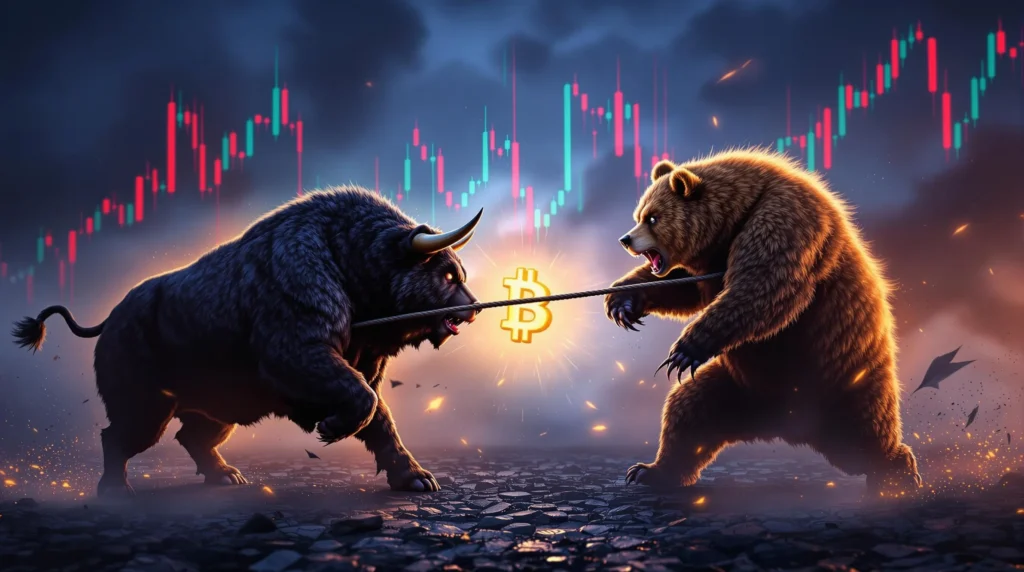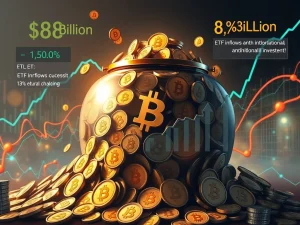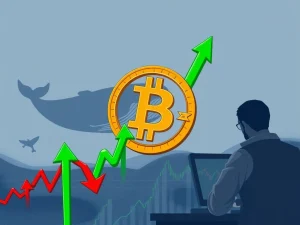Alarming Signals: Muted US Treasurys Demand – Is Bitcoin’s Bull Run at Risk?

The financial world is sending out mixed signals, leaving investors on edge. While the US Dollar Index recently dipped to a 70-day low, typically seen as a potential tailwind for risk assets like Bitcoin, a more concerning trend is brewing beneath the surface: muted demand for long-dated US Treasurys. This isn’t just an obscure financial metric; it’s a flashing warning light that could have significant implications for the crypto market, and particularly for Bitcoin. Is this a temporary blip, or are we witnessing the start of a deeper economic shift that could jeopardize Bitcoin’s bullish momentum? Let’s dive into the details and decode what this means for your crypto portfolio.
Decoding the Muted Demand for US Treasurys
First, let’s understand what US Treasurys are and why their demand matters. US Treasurys are debt instruments issued by the U.S. government, considered among the safest investments globally. Long-dated Treasurys, like 10-year or 30-year bonds, are particularly sensitive to expectations about future economic growth and interest rates. When demand for these long-term bonds weakens, it’s often interpreted as a signal that investors are becoming less confident about the long-term economic outlook.
Why is muted demand alarming?
- Economic Uncertainty: Low demand can indicate concerns about future economic growth, inflation, or even potential recession. Investors might be hesitant to lock in their money in long-term bonds if they anticipate economic turbulence.
- Rising Interest Rates: Muted demand can push Treasury yields higher. When yields on safe assets like Treasurys rise, they become more attractive compared to riskier assets like Bitcoin, potentially diverting investment away from crypto.
- Funding Challenges for the US Government: Reduced demand can make it more expensive for the US government to borrow money, which could have wider fiscal implications and impact market sentiment.
Think of it like this: US Treasurys are often seen as the bedrock of the global financial system. If the foundation shows signs of weakness, it can create tremors throughout the entire structure, including the volatile world of cryptocurrencies.
The US Dollar Index Dive: A False Dawn for Bitcoin?
Now, let’s address the seemingly positive news: the US Dollar Index (DXY) falling to a 70-day low. Typically, a weaker dollar can be bullish for Bitcoin. Why? Because Bitcoin is often priced in US dollars, and a weaker dollar makes Bitcoin relatively cheaper for investors holding other currencies. Historically, there’s been an inverse correlation at times between the dollar index and Bitcoin’s price.
However, it’s crucial to avoid simplistic interpretations. A falling dollar index isn’t always a straightforward ‘buy signal’ for Bitcoin. Here’s why:
- Context Matters: Why is the dollar falling? Is it due to broad dollar weakness, or is it specific to certain economic factors? If the dollar is falling because of concerns about the US economy (which could be linked to muted Treasury demand!), then it might not be bullish for Bitcoin in the long run.
- Risk-Off Sentiment: In times of genuine economic fear, investors might flock to the dollar as a safe-haven asset, even if long-term prospects look uncertain. Conversely, if the dollar is weakening due to a perceived decrease in risk, it *could* benefit risk assets like Bitcoin. But the muted Treasury demand suggests risk is *increasing*, not decreasing.
- Global Liquidity: The dollar’s strength impacts global liquidity. A strong dollar can tighten global financial conditions, while a weaker dollar can ease them. However, if the underlying reason for dollar weakness is economic concern, the overall liquidity picture might still be negative for risk assets.
In short, while a weaker dollar *can* be a positive factor for Bitcoin, it’s essential to look beyond the headline and understand the underlying reasons. In this case, the muted demand for US Treasurys casts a shadow over the seemingly positive dollar dip.
Interest Rate Hikes and Bitcoin’s Tightrope Walk
The elephant in the room remains interest rates. Central banks around the world, including the US Federal Reserve, have been aggressively raising interest rates to combat inflation. This has a direct impact on the appeal of various asset classes, including Bitcoin.
How do rising interest rates affect Bitcoin?
- Increased Cost of Capital: Higher interest rates make borrowing more expensive. This can reduce investment in riskier assets like Bitcoin, as investors may prefer safer, yield-generating assets.
- Higher Discount Rates: In financial modeling, higher interest rates increase the discount rate used to value future cash flows. This can negatively impact the present value of assets like Bitcoin, which are often seen as long-duration assets with potential future growth.
- Competition from Bonds: As Treasury yields rise (due to factors like muted demand), they become more competitive with Bitcoin as an investment. Investors seeking yield might find government bonds more attractive than the volatility of crypto.
The current environment of rising interest rates and muted Treasury demand creates a challenging backdrop for Bitcoin. It suggests that the cost of capital is increasing, and safer assets are becoming more appealing. This doesn’t automatically mean Bitcoin will crash, but it does mean the path to new highs might be significantly more challenging.
Navigating the Crypto Market Storm: Strategies for Investors
So, what does this all mean for you as a crypto investor? Is it time to panic sell your Bitcoin? Not necessarily. But it’s definitely a time for caution, strategic thinking, and potentially adjusting your portfolio.
Actionable Insights for Crypto Investors:
- Stay Informed: Keep a close eye on macroeconomic indicators, especially Treasury yields, the dollar index, and inflation data. These factors will heavily influence the crypto market in the coming months.
- Risk Management is Key: Now is not the time to be overly leveraged or take excessive risks. Consider reducing your exposure to highly volatile altcoins and focus on fundamentally strong assets.
- Diversification: Don’t put all your eggs in one basket. Diversify your portfolio across different asset classes, not just within crypto, but also potentially into traditional assets that might perform better in a higher-interest rate environment.
- Dollar-Cost Averaging (DCA): If you believe in the long-term potential of Bitcoin, consider using a dollar-cost averaging strategy to gradually build your position rather than trying to time the market.
- Focus on Fundamentals: In a potentially turbulent market, projects with strong fundamentals, solid use cases, and active development are more likely to weather the storm. Research thoroughly before investing in any crypto asset.
The Unpredictable Road Ahead: Is Bitcoin Still a Safe Haven?
The question of whether Bitcoin is a true safe haven asset is constantly debated. While some argue it acts as a hedge against inflation and traditional financial instability, others point to its high volatility and correlation with risk assets.
The current situation with muted US Treasury demand and a fluctuating dollar index highlights the complexities. Bitcoin has shown resilience in the past, navigating various economic headwinds. It has the potential to act as a store of value in a world facing inflationary pressures and economic uncertainty. However, it’s not immune to macroeconomic forces, especially rising interest rates and shifts in investor sentiment.
Moving forward, Bitcoin’s price action will likely be a tug-of-war between these competing forces. On one hand, concerns about economic growth and potential inflation could drive some investors towards Bitcoin as an alternative asset. On the other hand, rising interest rates and risk-off sentiment could weigh on its price.
Conclusion: Navigating the Uncertainties and Seeking Opportunities
The muted demand for long-dated US Treasurys is indeed raising alarm bells, and the recent dip in the dollar index might be a deceptive calm before a potential storm. While the situation is complex and unpredictable, it’s crucial for crypto investors to stay informed, manage risk effectively, and be prepared for potential volatility in the crypto market. The interplay between interest rates, the dollar index, and demand for safe-haven assets like US Treasurys will continue to shape the landscape for Bitcoin and the broader crypto ecosystem. By understanding these dynamics and adopting a prudent investment approach, you can navigate these uncertain times and potentially position yourself to capitalize on future opportunities in the ever-evolving world of digital assets. The key is to remain vigilant, adapt to changing market conditions, and remember that in the world of crypto, knowledge and preparedness are your greatest assets.









